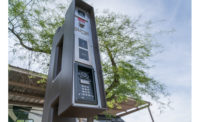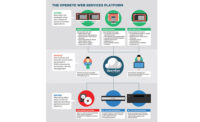A few short years ago choices in power supplies were pretty straightforward; often it came down to price. Linear power switches worked very well and power supplies were a necessary item that wasn’t given too much thought. Like much of the security industry recently, however, that has changed with the advent of lower-powered IP devices, Power over Ethernet (PoE), more IT influence in security, and a shift to more intelligence in all devices — including power supplies — that can actually help the security integrator increase his recurring revenue.
“For years the lowly power supply section of the industry has been almost a commodity product,” says Joseph Holland, vice president of engineering, Life Safety Power (LSP), Mundelein, Ill. “The [past the past six years] signify real change in the industry and a snapshot of what is coming down the road.”
Bill Allen, director of marketing, Minuteman Power Technologies, Carrolton, Texas, adds, “As security markets and devices move more and more into IP technologies, no longer does the security system operate as a separate entity. It is now running on the backbone of the network.”
As a result power supplies and backup power supplies are required to provide more power in some cases, less in others; be more intelligent and connected to the network and mobile devices; and generally be a more integral part of the overall security solution. Power supplies are no longer just a power converter on a wall.
For integrators, these changes mean more responsibility to choose the right power supply and method for the situation. But on the positive side, they also present an opportunity for more sales and recurring monthly revenue.
Size, Type & Distribution
As more security systems become IP based, the advent of the “edge” device means that power supplies may also be required at the edge.
“You need more disparate units,” Allen says. “Everything is spread out. There are so many different nodes that plug into the network. We are seeing a definite trend of lower power requirements. Chips are becoming more efficient and the power requirements are going down; but the trend of more and more remote devices across facilities means more demand for smaller units.”
This is true for both uninterruptible power supplies (UPS) such as those provided by Minuteman and also power supplies that convert 120 volt power to 12 or 24 volt for most security equipment.
“Many power supplies are now located at the devices that need to be powered,” says Trudy Phillips, director of sales and marketing, Elk Products Inc., Hildebran, N.C. “Even if the control panel includes a good power supply, systems are larger now, requiring a longer run to the devices. The longer the run, the less power you can actually deliver to the device. It is more common today to put the power supplies out near the devices.”
In access control systems, particularly, the trend is going to more power supplies as systems get larger and larger, says Aaron McGhee, group leader for hardware, Digital Monitoring Products (DMP), Springfield, Mo. “It is not a single door but multiple doors now. These draw more power and now you have more power supplies in different parts of the building.”
However, on the flip side, centralized, or “hub-and-spoke” systems are not only still around, but that model is now requiring even more power than before. “We are seeing the trend from both ends: more power consumption at the high end and less at the bottom end,” Allen says.
Holland calls these “unified power systems.” LSP is working with several major access control manufacturers to combine controllers and power supplies into one unit. “We are actively supporting these guys to take bigger controllers, put them in our cabinetry and reduce the wall footprint of what is needed in the equipment room. We can put all the equipment needed for a given system into one cabinet, use one AC drop instead of three and reduce it to one cabinet,” he describes.
In some cases, lower power security equipment means the same power supply that used to power one device can now power two or more, adds David Corbin, senior product manager, Securitron, an ASSA ABLOY Group company, Phoenix. “Take a 1 amp supply, for example. Previously with a solenoid lock that would be one power supply per lock. Now if you are taking 1 amp and that device now has a one-half amp requirement, you can now potentially put two locks on it.”
In many cases the choice of hub-and-spoke or edge power supplies is still truly up to the integrator and often a matter of preference.
“Some like the hub-and-spoke model with a big power supply in a closet and running lines to multiple doors,” Corbin says. “Others prefer one door per power supply because it simplifies installation.”
The idea of traditional locking solutions where you were drawing large amounts of power and voltage drop was a concern is less of an issue now with low-power devices, he adds. “You might be at 21 or 22 volts instead of the original 24 by the time you are at the lock. But many of these low-power locks accept any voltage from 10 to 30 volts, so you can potentially run that to 1,000 feet of cable and not have enough voltage drop to impact it. It depends on what you are powering.” Some access control readers have distance limitations due to the data cable.
Power supply types have changed, as well. Linear power supplies are still in use, but they are quickly being supplanted by the more efficient switching variety.
“We have been selling linear technology power supplies since the 1970s,” Corbin explains. “Within the last five years we have started offering a full line of switching power supplies. They are higher efficiency than linear and have gotten much cleaner in the power they deliver. There are still integrators in certain markets, including government applications, where linear is required because of reliability. But I predict linear is on a downward trend and switching is on an upward one. As switching gets more efficient and people recognize the reliability, it will overtake and eventually replace linear.”
In fact, Securitron’s latest power supply is a switching type that will reduce power consumption of the overall door by 99 percent. “We are getting ready to launch a line of efficient power supplies that are designed to go to sleep when no load is attached,” Corbin describes.
Another big change on the horizon is PoE, a low power source that is starting to be implemented to power locks and other security peripherals.
“Right now each reader is powered by DC voltage generated from a power supply somewhere,” Allen says. “I think eventually each access control reader will be an IP device and get its power from a PoE switch.”
Holland points to a new PoE standard, 803.2 BT, which will be a higher level of PoE power than has yet been implemented. “It will be a major change in the industry and I expect to see a whole lot of change in the power side of things, including features, functions and overall integration becoming simpler and more direct and taking up less space in a given area. The power supply of the future, if they go along with this new standard, will be PoE based.”
Features & Functions
Power supplies are also getting smarter, which means they can now help the integrator monitor power and individual points — creating RMR potential.
“IT managers and those folks that run IT-based systems have been using a number of monitoring and management vehicles to know what is going on with power in their systems for a long time,” Allen says. “Power monitoring software that runs on a PC can go across the network and see what is happening with power.”
This IT tool is called simple network management protocol (SNMP), a term that is starting to become more familiar in the security power supply world as these devices become more intelligent and feature-rich.
“In the UPS world we have seen the trend to smarter units for many years in the IT community,” Allen adds. “In security this is a trend that is coming more slowly as we move from the old analog to IP-based systems. Everyone in security needs to get used to this concept. Many in the industry don’t even know what SNMP stands for.”
Power monitoring benefits security systems. “Through the network we can even directly control system elements from the office over the Internet,” Holland explains. “For example, older analog cameras tend to freeze under various circumstances. The only solution is to reboot them, but you have to pay a lot of money for that tech to get in a truck and go out to the site. If you can instead walk to the computer in your office, dial that system, shut the power to a given camera and bring it back up 20 seconds later, this is a big advantage.”
Power diagnostics over the Internet can also bring an RMR opportunity for the integrator, he adds. “If the integrator desires, he can offer that service to a customer for a fee, which adds to the recurring revenue as a monitoring service.”
Minuteman’s new Remote Power Manager allows for this, Allen says. “We are selling to integrators for managed services. They can help end users manage all these devices and charge money for it. Since everything is IP-based they can have access to it externally.”
Most power supplies today have at least some capability of communicating over email, text or other methods.
“Our systems can be supervised. They can send messages via text message, push notification, or to a central station to notify you of low battery or AC failure,” McGhee says.
“One of our newer products is a physically small power supply that fulfills the supervision need,” says Amy Strickland, marketing design manager for Elk Products. “Also within the past couple of years we have added supervision over data bus to a specialized power supply. We are seeing a lot of those being installed.”
Phillips adds, “IP has made our control product more useful to the consumer, because there is more information coming back to them, as well. With everyone carrying smartphones and tablets these days, it has made the product more user friendly and accessible.”
Securitron’s new EcoPower units will have microprocessors onboard, Corbin says. “More and more people are asking for monitoring capabilities. But it is still a very small slice of the overall market, and right now a premium priced product. There are also companies offering modules that can be added to power supplies to monitor voltage and current.”
LSP’s mobile communications can come directly from the power supply or through the system, Holland says. “If you wanted to, you could dial into the system from your phone. Our software is browser-based.”
He has also seen integrators take messages from their power supplies and integrate SNMP error messages to feed it to the access control software to bring alerts onto a monitoring screen. “These integrators understand where the industry is going and they are taking full advantage of technical advancements that have been made across the board. They have something to offer the customer that nobody else can.”
These types of opportunities and options will only continue to grow, Allen adds. “The security industry in general is going through a huge turn in terms of IP technologies. Security folks that specify systems are going to have to be aware of IT-based technologies such as power management and SNMP going forward.”
SIDEBAR: Backing up the Power
Power supplies are often the last line of defense against losing power. Centralized or distributed UPS protect the system from harmful surges and provide the first line of battery backup in the event of a power loss.
“Security products are like anything else that runs on electricity,” says Bill Allen of Minuteman Power Technologies. “If they don’t have it, they don’t run. You can have a wonderful power supply, but if there is no AC power present, it won’t operate. We provide the backup function of that power.”
UPS also provide filtering to make sure the power that reaches the devices is clean. “You have switches and routers that power all these IP devices. But if those don’t have good clean power, they don’t function correctly,” he explains.
While there isn’t always a requirement to provide backup power, most security integrators today understand that battery backup is a good practice. What they might not understand is how much is needed.
“We have pretty much gotten to where most installers will not install a security system without some sort of battery backup,” Allen says. “The biggest question they run into is ‘What UPS do I need for this particular system?’”
Allen recommends asking the end user how long they want it to run without AC power. “Obviously with security being very important these days, there is definitely a trend to more and more run time requirements. Instead of 15 minutes they want two hours.”
Minuteman has an online tool that takes the guesswork out of which to use. The online database makes it easy for resellers to configure an entire system by manufacturer and model number. Customized data sheets for particular configurations show what unit and run time will result from a specific system. “If they don’t see it on the list they can go to the product datasheet on the manufacturer’s website and plug it in manually,” Allen says.
Power supplies themselves also have battery backup. These aren’t so much a matter of user preference as they are specific to the load and type of equipment.
“The load of the devices is how you figure that out,” says Aaron McGhee of DMP. “Choose a battery backup by how long you want the system to run after power has failed. If the load on that supply is quite large, you will need more amp hours on your battery to last for the amount of time required. If that amperage or load is high and you don’t have enough amperage on the battery, then as soon as power dies the battery will die, as well.”
Some industries and applications — such as fire systems, medical and critical infrastructure — have specific battery backup requirements. When in doubt ask the manufacturer for help figuring out what size battery to use. Many have a variety of online calculators and tools to help.
SIDEBAR: Avoiding Common Pitfalls
With more options than ever before, integrators can sometimes run into problems when choosing a power supply.
One of the most common pitfalls is over — or under — powering by choosing the wrong-sized power supply. “One of the main questions we get is ‘What size power supply is needed?’” says Amy Strickland of Elk Products Inc. They need to know voltage requirements on their equipment; current requirements; what size battery they need if they are going to have battery backup; and whether they need supervision. Those are the basic questions we ask them.”
Strickland says a frequent issue is integrators under-powering or having overcurrent conditions because of not getting enough power. “You find some devices such as siren drivers that have adjustable volume. You might have enough power for lower volume but if you turn the volume up, it stops working. Power varies depending on how it is installed and what is connected to it. Sometimes it is a moving target.”
David Corbin of Securitron, an ASSA ABLOY Group company, says the biggest problem he sees on a day-to-day basis is the installer who always uses the same power supply for every situation, no matter how big or small. “You end up with vastly oversized power supplies or ones not optimal for the situation because the installer is taking a 6 amp power supply and slapping it on the wall. That can impact the end user because they are operating less optimally, so their electrical costs will be higher. There is nothing specifically wrong with doing it that way, but it is much less efficient. We find that no one thinks about the power consumption of access control because it is vital to building security. But what if you turn that on its head and say it is possible to have reliable access at a fraction of the energy consumption?”
Sometimes mistakes are very basic like getting a 12 volt DC supply when a 24 was needed. “Check and double check,” says Aaron McGhee of DMP. “There is a lot of documentation online on our website. It is easy to check amperage and voltage from a mobile platform. All of our products have a voltage listing printed on them so you know how much that device draws.”
For Joe Holland of Life Safety Power, the “old” way of thinking about power supplies is the biggest pitfall of all to overcome. “Integrators tend to think of the power supply as a commodity item and throw anything in there based on price. Another problem I see is in the old days people made their power supplies very lean, cheap and they would not provide the necessary amount of power on a continuous basis. So if you needed a 6 amp power supply, you had to buy a 10 amp device to get that. Some people tend to still think like that.”







